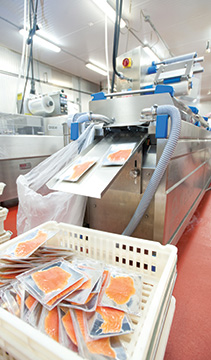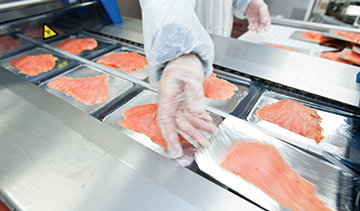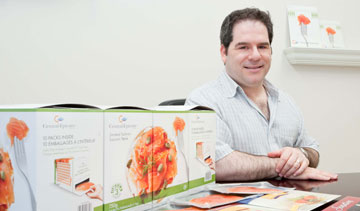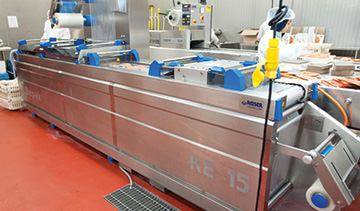
Smoked out of water
By Andrew Joseph, Features Editor; Cole Garside, Photographer
General Branik Smart Tech Inc. Custom CO-EX Technologies Inc. Kruger Inc. Lewis Systems Transport Norampac (Div. of Cascades Inc.) Packall Packaging Inc. Reiser (Canada) Ltd. Rock-Tenn Company Total Pac And Design Inc. Walden DesignDesire to produce innovative packaging for smoked fish leads to purchase of new horizontal packing machine.
(This article originally appeared in the June 2013 issue of Canadian Packaging magazine.)
Calling oneself an epicurean—a culturally-refined person who takes great pleasure in fine food and drink—can make it a lot to live up to.
Fortunately for the aptly named Central-Epicure Food Products Ltd., situated in an attractive 40,000-square-foot facility in the north part of Toronto, confident self-assurance has never been in short supply for one of Canada’s largest producers of packaged smoked fish for markets throughout the country, with strong focus on Quebec and Ontario.
Starting out as Central Smoked Fish back in 1952, the processor smoked and distributed a wide variety of fish products in the general Toronto area for many years, steadily building up its skillset and customer base.
After Harry Nadler purchased the business in 1974, he started to build up the company’s name in the industry—eventually deciding to change the name to Central-Epicure in 1997 to better reflect the range and quality of its products.
“During our long history, we have merged with or purchased a few other fish plants, and have incorporated their unique products, staff and expertise in with our own,” Central-Epicure vice-president of sales and marketing Michael Nadler told Canadian Packaging magazine during a recent visit to the busy facility oozing with tantalizing smoky flavors.
Son of company president and chief executive officer Harry, and the brother of Daniel, vice-president of production of Central-Epicure, Michael Nadler aptly personifies the company’s confident mindset.
“Here in Canada, we are one of the few facilities that have continued to focus on both hot and cold smoked fish providing a product catalogue that serves a wide range of customers,” he says.
Nadler explains that the company prefers to utilize a simple maple wood chip in its smoking process, so as to not impart any overly-heavy flavoring onto the already naturally tasty products.
While trout, mackerel and whitefish are just a few of the more popular species Central-Epicure smokes and distributes, it also processes sockeye and other Pacific salmons; Arctic char; sea bass; black cod; carp; chub; ciscoes; dace fish; halibut; herring; lake, steelhead, rainbow trout; and omul.
Plenty of Fish
Within this vast repertoire, cold-smoked Atlantic salmon is by far Central-Epicure’s bestselling fish, whose weekly output of 25,000 pounds accounts for two-thirds of the total 35,000 pounds for all of the fish processed by the company’s 60 employees per week.
When speaking about sustainability, Nadler explains: “We are MSC (Marine Stewardship Council)-certified, and we make the best-suitable available choices we can when sourcing our products.
“We have already begun purchasing BAP (Best Aquaculture Practices)-farmed fish, and we plan to be 100-percent BAP-sourced by the end of 2013.”

Along with private-label production for Sobeys and Walmart, Central Epicure introduced a new 10-pack of its frozen smoked salmon for sale at Costco, sparking the introduction of an innovative portion-control box for the retail segment.
Nadler says that while Central-Epicure is very customer-focused, product safety always comes first. Hence not only has it been a Canadian federally-registered seafood facility with a recognized HACCP (Hazard Analysis Critical Control Points) plant for many years, it was indeed one of the first fish plants in Canada to embrace the principles of HACCP and QMP (Quality Management Program).
The company is also active within the Fish and Seafood Association of Canada, the Fisheries Council of Canada, and via its appointment to the Technical Sub-Committee of SIPAC (Seafood Inspection Policy Advisory Committee), it has also been helping format federal fisheries legislation for more than 20 years.
“We are also Gold-rated by the GFTC (Guelph Food Technology Centre),” Nadler notes.
In addition, the plant is also certified as a Kosher producer, and is scheduled to receive GFSI (Global Food Safety Initiative) status in August of 2013.
“We strongly believe in the sanctity of food safety as one of our first priorities,” notes Nadler, adding that “laboratory testing of our fish products, plant environment, and production personnel are performed on a regular basis throughout the day to ensure our products are not only tasty, but are perfectly safe to consume.
“As part of our safety initiatives, we ‘fog’ our plant nightly with a disinfecting spray that kills mold, mildew and bacteria—ensuring that our employees begin each workday with a sterile work environment,” he relates.

The Reiser RE15 quickly vacuum-packs 75-gram packs of frozen smoked salmon, depositing them into trays supplied by Lewis System Transport.
Central-Epicure produces about 80 per cent of its smoked fish under its own flagship brand label, which can be found most recently at Costco, while 20 per cent of the business is for private-label brands, for such leading retailers like Sobey’s and Walmart.
“We tend to focus on the smaller packages aimed at the consumer who uses smoked salmon for their everyday consumption, although we also supply hotels, convention centers and foodservice outlets,” says Nadler, adding the company also sells directly to notable upscale Toronto eateries like United Baker’s Dairy Restaurant, Caplansky’s Deli, Bagel World and Kiva’s, to name just a few.
Says Nadler: “These deli shops all use our smoked salmon because their customers are smoked salmon connoisseurs, and only the best will do for this crowd.”
It wasn’t until 2004 when Central-Epicure began to increase its focus on packaging development with the introduction of its Fresh-Never-Frozen smoked salmon-product to grocery stores.

A Central-Epicure worker hand-places carefully-weighed 75-gram portions of smoked salmon onto the bottom film running on the RE15 vacuum-packing machine from by Reiser.
Nadler says the company selected a cardboard-type sleeve to use over the vacuum-bagged fish, rather than the then-common plastic printed pouch or bag, because it wanted to get more vibrant colors on the packaging to attract attention of the consumer.
As well, Nadler points out it was necessary to add a small window on the back of the first paperboard sleeve so that the consumer not only caught the eye-grabbing graphics of the fish, but could also see the size of the portion of the actual product they were purchasing.
Smoking Hot
“The growth in sales on our smoked salmon at the grocery stores has been nothing short of phenomenal,” says Nadler.
“In fact, only three months ago we launched a freshly-designed sleeve that also seems to be a big hit with not only our buyers, but with the consumers as well.”
Nadler says he is particularly proud of the special paperboard box the company retails in 52 Costco stores, where they are selling incredibly well.
Dubbed the ‘Lox Box’ by Nadler, who originally conceived the idea, the attractive multipack was designed by the Toronto-based Walden Design in conjunction with marketing consultant Natalie Kaplan.
Each box holds 10 sealed frozen 75-gram packs of sliced smoked salmon—each enough for two servings—and features a simple opening/closing system that allows the consumer to simply pull away a perforated portion on the lid of the box and insert the remaining tab into the appropriate slot—thereby creating an easy-access portal to remove a sealed pack of fish to thaw and eat as required.
“It’s a convenient way for a family to enjoy our smoked salmon product in ready-made portion-controlled packs every day.
“You only defrost the amount you need,” explains Nadler. “You just grab, thaw and enjoy.”

A Central-Epicure worker carefully fills the company’s new 10-pack ‘Lox Box’ of smoked salmon destined for retail shelves at Costco.
The design of the box allows for a billboard effect, whereby each box is only a modest 6×9-inch, it generates the overall effect of a 24 x9-inch posterboard.
“When you walk by, you can’t help but notice the package and thus, our smoked salmon,” he enthuses.
Nadler estimates the vast majority of all the smoked salmon sold in Canada is sold frozen, and says he recently purchased a brand new Reiser horizontal Repak RE15 form-fill-seal packaging machine to increase the company’s frozen salmon output capacity.
“I actually bought the Reiser to help us with our launch of products for Walmart, Sobeys and Costco in 2012,” admits Nadler, “but it has been a great overall addition to our production lines.”
The Repak RE15 is considered to be a small member of the whole Reiser machine family, but size aside, it is built to the same exacting standards as it larger brethren: with the same die-lift technology, superior frame design, and easy-to-use operator interface.
After the fresh salmon arrives at the plant, it is lightly-coated in a dry brine of salt-and-sugar to draw out moisture and to add texture, and allowed to dry for about 24 hours.
After drying, the brine is rinsed off the salmon, which is then placed into one of five smokers for an 18-hour cycle during which it is smoked-dried, and smoked again repeatedly, depending on the size of the filleted fish.
The fish is then cooled, skinned, trimmed of any excess fat to look perfect, and then placed through either a Branik Smart Tech Inc. SL 400 or ASA 400 slicer to produce thin, clean, delicately-sliced pieces of fish via two blades reciprocating back and forth, so as to not tear the flesh of the salmon.
“The machine is designed to know where the beginning and end of each fillet is, so that it can change the angle of its cut and slow down its slicing movement to get an optimum yield,” explains Nadler.
After slicing, line workers use their individual scales to measure out 75-gram portions of smoked salmon, and place it onto a gold foil-lined paperboard tray, which actually helps prevent the natural fish oils from spreading.
From there, the trays of fish are hand-placed into the RE15 to have a tight, safe vacuum seal generated around it. The Repak RE15 utilizes a rapid forming method that maximizes distribution of film into critical areas like corners.
“It works very quickly,” says Nadler. “We run it at a rate of 10 cycles or 20 packages per minute.”
Standard Fare
Other notable standard features on the Repak include the special four-point lifting systems on the forming and sealing dies, which create lots of closing pressure to ensure increased seal integrity and improved package reliability.
Along with vacuum-packing, the RE15 can actually produce MAP (modified atmosphere packaging) packs from flexible and semi-rigid materials, as well as Vacuum Skin Packages (VSPs), and packages with formed top webs.
“I really like the fact that my Reiser, like all the Repaks, is constructed out of stainless steel and has rounded edges, which makes it very easy for my sanitation crew to clean,” mentions Nadler.

Kruger supplies corrugated master shipping cartons to Central-Epicure for transport of its packaged fish products to customers across Canada.
Also providing easy access for maintenance, Nadler says the operator touchscreen is very easy to understand and use.
“So when we are in a rush, which is always, product changeover can be achieved in about four minutes.”
For Central-Epicure, the Reiser machine has been nothing short of amazing, according to Nadler.
“From the moment they came in to set it up, they taught us how to do everything,” says Nadler. “Seriously, I’ve been giving out the Reiser name to everyone.”
Other packaging equipment and supplies utilized by Central-Epicure include:
- A Reiser Dixie Union brand Dixiepak 50E vacuum-packing machine;
- Plastic films supplied by Packall Packaging and Custom CO-EX Technologies;
- Plastic trays from Lewis Systems Transport;
- Corrugated cartons made by Kruger, Norampac and RockTenn;
- Pressure-sensitive labels and other packaging materials provided by Total Pac and Design.
“Packaging is a huge issue for us,” states Nadler.
“We make a great-tasting smoked salmon, but you can’t taste it until you buy it1, since it looks pretty much like anyone else’s product until you get it into your mouth.
“That’s why we have been focusing our attention on images and packaging for a long time,” Nadler relates.
“And while our products are for the most part more expensive than the competition, we are confident that people prefer quality and will keep coming back for it.
“And that is why we depend on our packaging to help people choose ours in the first place,” he states.
Although Nadler notes that Central-Epicure’s greatest competition comes worldwide from companies operating out of China, Norway and Chile, he is quite confident of his own product’s growth potential.
“We’ve been successful in the Canadian marketplace for one simple reason: We make the best-tasting product on the market.
“We make a full-flavored smoked salmon for the people who truly love smoked salmon,” Nadler sums up.
It’s a simple recipe for success that has worked very well for us so far.”
Advertisement



